Despite the simple design of the SHS, it is quite difficult to make screw piles with your own hands. For easy screwing into the ground, a certain inclination of the spiral blade is required, its correct location on the cone of the tip.
For screw piles, there are no GOSTs, so even industrial manufacturers often sell products with the wrong dimensions, tip geometry. To ensure a high service life of the foundation, it is necessary to adhere to the dimensions in the drawings below.
Despite the variety of designs, factory-made and home-made screw piles have several elements:
- body - a pipe with a diameter of 76 - 350 mm, a wall of 4 mm;
- tip - cast, welded peak (recommended length 2 diameters) or a cone made from the pipe body;
- blades - one double-start or single-start spiral or two propellers at a distance of 0.4 - 0.7 m from each other (for seams with a weak bearing capacity);
- head - relevant for wooden grillages (log houses, frame, panel, panel houses), it is a plate with holes, reinforced with stiffeners, welded to a coil from a pipe, the inner diameter of which is slightly larger than the outer size of the pile body.

Screw pile design drawing.
The foundation of the metal grillage on screw piles is assembled without heads. Channel, I-beam are welded directly to the body of the pile, protruding above the ground.
Making screw piles with your own hands - step by step
When designing the above elements of the SHS, it is necessary to focus on the drawing of any manufacturer of screw piles. This will make it possible not to make mistakes in the landing dimensions of the blades and to minimize the number of welds, each of which weakens the metal in the immediate vicinity of the joint.
pile body
The manufacture of SHS begins with the selection of pipes that make up the foundation. Experts recommend adhering to the specifications of manufacturers:
- St20 - corresponds to GOST 8732;
- 09G2S - corresponds to GOST 19281.
Pipes made of these materials are quite easy to cut, bend the petals in the manufacture of the tip peak. The standard length of the SHS is 2 - 3 m, if it is necessary to dive to great depths, in order to guarantee the achievement of the bearing layers, the pile is built up with a pipe after screwing in by 1.5 - 2 m.
Tip options
There are three options for the tip for a homemade screw pile. All of them differ in manufacturing technology, the size of parts. For dense soils, welded peaks or tips made from the pipe body are best suited. When screwing SHS into peat, sand or sandy loam, cross-shaped tips can be used. The design of the peak practically does not affect the resource of the foundation, only the tightening force on the levers changes.
Manufacturing using this technology will require an increase in the pipe body by a length of two of its diameters, since one end of the pile blank turns into a tip. The method consists of a sequence of operations:
- making a template - a triangle is cut out of cardboard, paronite or pipe;
- marking - the end of the tubular blank is marked according to the template into several sectors;
- pipe cut - jagged petals are made along the chalk lines at the end of the pipe;
- bend - the petals obtained at the previous stage are bent into a cone, the top of which must coincide with the axis of the pipe;
- welding - the petals are welded to each other with a double seam.

Procurement of a screw pile tip from a pipe body.
When marking up a template, consider:
- for pipes with a diameter of 108 - 200 mm, it is better to make 5 petals;
- for 76 - 89 mm pipes, 4 petals are enough;
- the short side of the triangle is equal to πD/n, where n is the number of petals, D is the pipe diameter;
- the height of the triangle is equal to or slightly more than twice the outer diameter of the pipe.
The resulting peak has the shape of a cone, which is very convenient for welding the blade blank. To make SHS using this technology, you will need a welding machine (inverter), a plasma cutter / gas cutter or an angle grinder with a tool for metal (cutting disc). The foundation is guaranteed to sink to the design layer, the peak easily pushes small stones apart, crumbles large boulders.
Welded tip
For foundations of small architectural forms and light buildings, welded tips made using a similar technology can be used:
- cut of the petal - the development of the triangle is performed in a similar way from sheet steel (4 - 5 mm) or a pipe of the same diameter as the pile body;
- tip assembly - the petals are installed close to each other, the resulting cone is seized by welding;
- production - double welded seam on tacks.
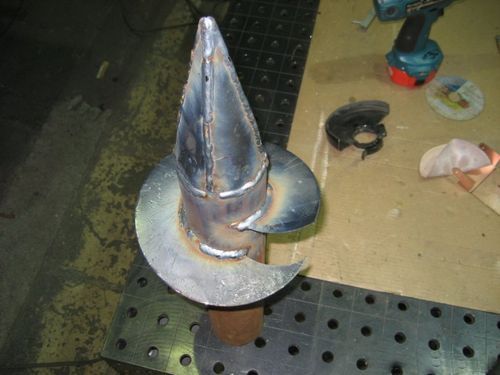
The tip is welded from 4 triangular blanks (pyramid).
The blades are more convenient to dock to the peaks of the petals cut from the pipes, rather than to the pyramids of sheet steel. In any case, the drawing below is used.
cross tip
The third method of making the tip uses different drawings. The technology looks like:
- cut parts - triangle + stiffeners + round plate-stub for the pipe;
- assembly of the structure - a large triangle is installed on the plug, two stiffeners (at right angles to the plate), are stuck in several places;
- welding joint - all joints are scalded with a double seam.
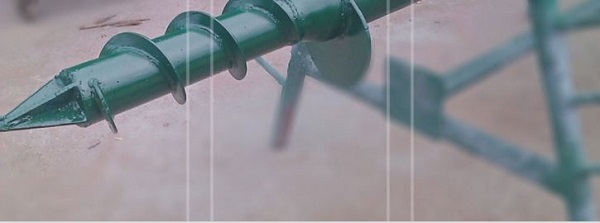
Pile with a cross-shaped tip.
The big triangle is:
- the lower side is equal to the diameter of the round plug (outer pipe size);
- the height is π x D.
When choosing a cross-shaped tip, it must be taken into account that the blades (pile auger) in this case are welded above the peaks. This is the only drawback of this design, which increases the tightening force.
Blade manufacturing
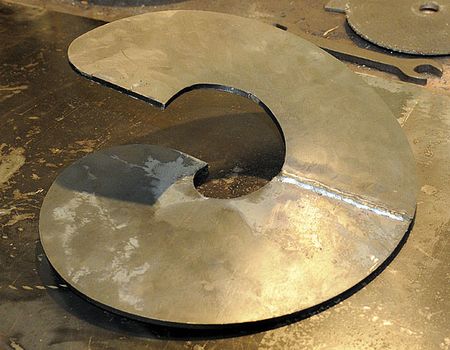
Single blade.
Piles are most easily twisted, the screw of which starts in the lower third of the tip, the blade pitch is 5–7 cm. This SHS element has a complex configuration, it is made of thick sheet steel from 5 mm. Therefore, blades can be made in several ways:
- a solid single-thread screw - cutting a sheet blank according to the given drawing, distributing the blade with a crowbar, mounting to the required pitch size;
- a prefabricated screw from several blanks - cutting individual segments (half a circle maximum), sequential welding of each of them to the peak, the body of the pile.
In the first case, it is physically impossible to perform more than one screw run. But the element has maximum spatial rigidity, stable geometry.
In the second variant, it is possible to assemble a multi-entry screw, but it is difficult to maintain the spiral configuration.
A single-throw blade is created in the following way:
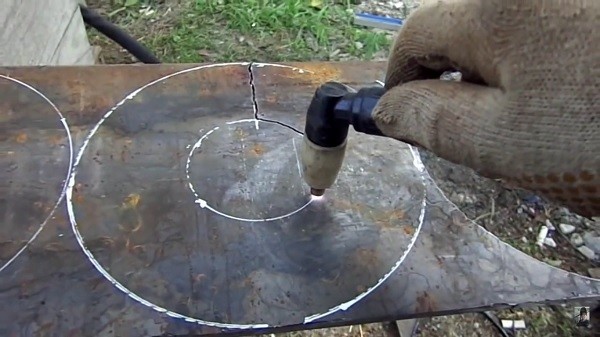
Cutting a blade for a pile with a manual plasma cutter on chalk markings.
- marking - the outer diameter of the workpiece is 15 - 30 cm, depending on the load on the pile (usually 20 - 25 cm), the inner diameter is equal to the outer size of the pipe (for homemade piles more often 76 - 108 mm), a segment is drawn in an arbitrary place connecting the inner circle with outdoor;
- cut - the part is cut out from a 5 - 7 mm sheet by plasma cutting, gas cutting or welding, taking into account the width of the cut, subsequent processing of the seat (inner diameter);
- wiring - the area opposite the cut between the outer / inner diameter is clamped in a vice or a slot in a massive structure (porch, gate, pole with a fence section), the edges of the blade are unclenched with a crowbar or a crowbar with constant control of the auger turn pitch.
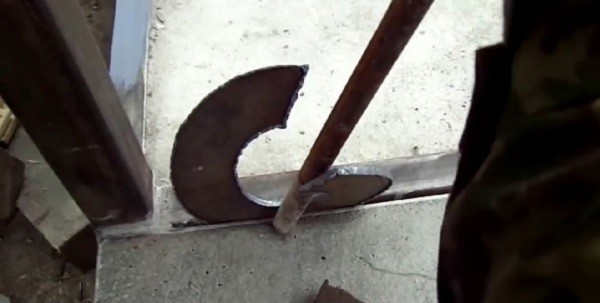
Bending a screw pile blade with a crowbar.
You can make multi-thread auger blades using the technology:
- marking - the inner diameter is equal to the outer size of the pipe (pile body), the outer one is 20 - 30 cm, the resulting ring is divided into two segments into identical half rings;
- curly cut - cutting along the markup in any sequence with a professional tool;
- installation on a pile - on a peak, a pipe, it is necessary to create a screw marking, attach the first half ring, grab it, checking the perpendicularity of the pile body, then place the remaining half rings along the line, depending on the required number of turns of the SHS auger. If necessary, the half ring is slightly bent.
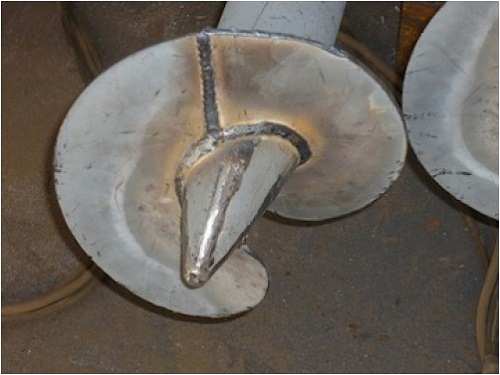
Multi blade.
The easiest way is to weld the auger or segments of the prefabricated screw to the pile body, since the pipe section is constant throughout its entire length. The conical tip tapers, so the inner diameter of the blade must be smaller in this area. Therefore, the template for this element can be adjusted directly in place, using sheet material of sufficient rigidity (paronite or cardboard).
Anti-corrosion treatment
For maximum service life, the elements of the pile foundation must be protected from corrosion. Every year, pipes, blades lose 0.01 mm of wall thickness due to rust of metal immersed in the ground. Experts recommend coating SHS after removing scale from welds with the following compositions:
- polyurethane enamel - manufacturers Hempel, Masko, applied to the primer VL05, has a 30 - 60 year resource;
- two-component enamel - modifications IR02 or Zinga Metal, resource 60 - 90 years, created to protect underground metal structures;
- fiberglass - applied to a cold zinc coating (IR02 + primer VL05), provides 300 - 400 years of service life, successfully resists electrochemical corrosion.
For budget buildings, two-component paintwork based on epoxy resins is usually used.
Video
Advice! If you need contractors, there is a very convenient service for their selection. Just send in the form below a detailed description of the work to be done and you will receive offers with prices from construction teams and firms by mail. You can see reviews of each of them and photos with examples of work. It's FREE and there's no obligation.



